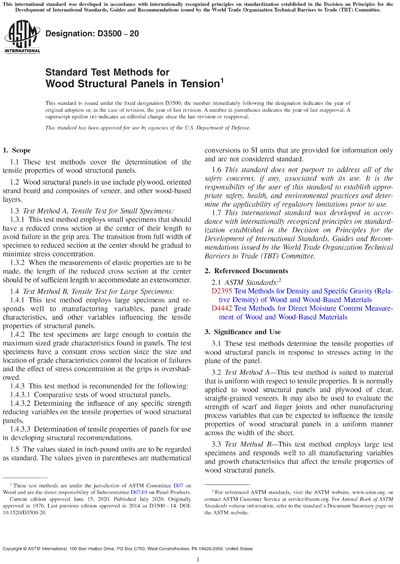Most recent
ASTM D3500-20
Standard Test Methods for Wood Structural Panels in Tension
1.1 These test methods cover the determination of the tensile properties of wood structural panels.
1.2 Wood structural panels in use include plywood, oriented strand board and composites of veneer, and other wood-based layers.
1.3 Test Method A, Tensile Test for Small Specimens:
1.3.1 This test method employs small specimens that should have a reduced cross section at the center of their length to avoid failure in the grip area. The transition from full width of specimen to reduced section at the center should be gradual to minimize stress concentration.
1.3.2 When the measurements of elastic properties are to be made, the length of the reduced cross section at the center should be of sufficient length to accommodate an extensometer.
1.4 Test Method B, Tensile Test for Large Specimens:
1.4.1 This test method employs large specimens and responds well to manufacturing variables, panel grade characteristics, and other variables influencing the tensile properties of structural panels.
1.4.2 The test specimens are large enough to contain the maximum sized grade characteristics found in panels. The test specimens have a constant cross section since the size and location of grade characteristics control the location of failures and the effect of stress concentration at the grips is overshadowed.
1.4.3 This test method is recommended for the following:
1.4.3.1 Comparative tests of wood structural panels,
1.4.3.2 Determining the influence of any specific strength reducing variables on the tensile properties of wood structural panels,
1.4.3.3 Determination of tensile properties of panels for use in developing structural recommendations.
1.5 The values stated in inch-pound units are to be regarded as standard. The values given in parentheses are mathematical conversions to SI units that are provided for information only and are not considered standard.
1.6 This standard does not purport to address all of the safety concerns, if any, associated with its use. It is the responsibility of the user of this standard to establish appropriate safety, health, and environmental practices and determine the applicability of regulatory limitations prior to use.
1.7 This international standard was developed in accordance with internationally recognized principles on standardization established in the Decision on Principles for the Development of International Standards, Guides and Recommendations issued by the World Trade Organization Technical Barriers to Trade (TBT) Committee.
Content Provider
ASTM International [astm]






